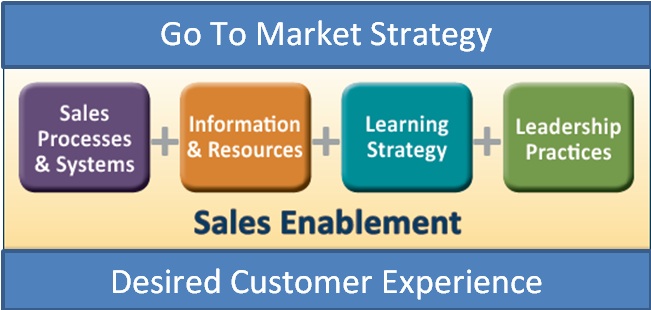
If you are a Learning and Development (L&D) professional who supports a sales organization, chances are high that your title and/or team name have changed recently. In the last few years, more and more companies have started to establish sales enablement functions—and the talent at the core of those functions is often the sales training team.
So what exactly is sales enablement, why does it matter, and what does it mean if you are an L&D professional whose title is now “Sales Enablement”?
What Is Sales Enablement?
Recently, Forrester Research defined sales enablement as “a strategic, ongoing process that equips all client-facing employees with the ability to consistently and systematically have a valuable conversation with the right set of customer stakeholders at each stage of the customer’s problem-solving life cycle to optimize the return of investment of the selling system.”
In other words:
Sales enablement is an approach that bridges the gap between the sales strategy and execution.
Why Does Sales Enablement Matter?
The emphasis on sales enablement grew out of pain. Sales executives across industries report that one of the biggest challenges their people face is information overload. Sales executives say things such as:
- “Our internal functions are competing for our salespeople’s time.”
- “Our salespeople receive conflicting messages from different sources within our own company.”
- “I see time being wasted in training that isn’t relevant to my team.”
- “We struggle to make sense of it all and our salespeople are wasting precious selling time.”
As companies sought solutions to this problem, people started to use the term, “sales enablement,” to refer to an approach in which all parts of a company work together to drive better sales results. Of course, it’s one thing to call a person or team “sales enablement”—it’s another to actually have a positive impact on sales performance.
My Title Is Sales Enablement—Now What?
It may be tempting to assume that L&D fits into sales enablement because L&D owns anything that has to do with sales training. But this interpretation limits the potential for L&D to make a significant impact.
Based on Wilson Learning’s ongoing work in the arena of sales effectiveness, we have identified four elements that must be aligned with a company’s go-to-market strategy and integrated with one another in order for any sales enablement approach to be fully effective:
- Sales Processes and Systems
- Information and Resources
- Learning Strategy
- Leadership Practices

Integrating these elements requires dialogue, shared commitments, agreements, and accountability among multiple functions. That’s where we as L&D professionals come in. Rather than just reorganizing or renaming sales training, genuine sales enablement requires us to reframe our role and rethink our work.
Reframing the Role: Breaking Down Silos
According to a Forrester report, “. . . you need to develop a team to work across traditional organizational boundaries and reporting levels within your company—and that’s a big challenge. But eventually, to be successful with sales enablement, you will need to break down the walls between organizational silos to get customers the information they need.”
Improving the alignment of the core functional elements, the go-to-market strategy, and the customer experience is the ultimate objective of sales enablement. Accomplishing this triple alignment requires coordination across multiple functions, including:
- Learning and Development
- Sales Leadership and Management
- Sales Operations
- Marketing
- Product Development/R&D
- Legal/Finance/IT
Fortunately, the ability to facilitate is right within our wheelhouse as L&D professionals. By stepping up and facilitating cross-functional collaboration, we can help our organizations:
- Identify barriers and supports to sales effectiveness
- Break down organizational silos
- Achieve alignment around the goals of the sales enablement function or team
- Build buy-in and commitment to an agreed-upon approach and work processes
- Identify and agree on short- and long-term priorities and action plans
- Implement action plans and evaluate effectiveness
As L&D professionals, we do not need to be experts in marketing and technology. However, it is critical that we partner with sales leadership to drive and facilitate alignment and coordination across all of the functions and people who support sales.
For example, an L&D leader in the tech industry offered to be the point person for a cross-functional sales enablement team. As the team looked at the problem of information overload and field confusion, they committed to coordinating efforts so multiple initiatives weren’t launched to the field at once. This particular team also agreed to allow individual functions to create their own sales tools and resources, yet they were required to follow templates and guides to ensure effectiveness and consistency.
Rethinking the Work: It’s About Performance, Not Programs
If you ask a roomful of Learning and Development professionals what the business needs from them, many will say things like “sales training programs” or “human performance improvement.” If you ask top executives and sales leaders what they need from training, you are more likely to hear “help equipping our people to drive sales.” Truly equipping people to drive sales involves not only designing and delivering training programs, but stepping into the shoes of salespeople and sales leaders and adopting a problem-solving mindset. What is it like to be a salesperson in your organization? What gets in the way? What do I need to be effective—more skills, more tools, more clarity? All of these are areas that we can influence, if not control.
To support sales enablement, L&D needs to:
- Develop a learning strategy that is aligned both with the organization’s go-to-market strategy and with the vision for the desired customer experience
- Partner with sales leadership to define the behaviors and mindsets necessary to execute on the organization’s specific objectives and go-to-market strategy
- Equip sales with the knowledge and skills to engage prospects and customers and drive sales forward
- Ensure sales leaders are equipped to coach salespeople toward higher levels of performance
- Act as performance consultants, helping to identify barriers to successful sales performance and drive solutions that go beyond training and development
- Provide learning and performance support tools in addition to instructor-led training
- Play the role of content managers, ensuring information is available in bite-size chunks when the sales team needs it, and in a format that is easy accessible
When these steps are employed, the results can be significant. For example, one organization adopted a new sales enablement focused learning strategy and was able to increase sales productivity by 15 percent. They achieved this by reducing time out of the field, increasing available selling time, reducing travel costs, and providing enhanced technology that made it easier for sales representatives to find and share resources based on individual buyer needs.
Enhanced Impact and Business Value
The growing emphasis on sales enablement provides an exciting opportunity for training leaders. By driving and demonstrating a collaborative, cross-functional approach, L&D professionals can help their organizations:
- Speed time to productivity for new hires
- Minimize disruption of both sales and sales support functions
- Reduce time out of the field
- Ensure consistent messages to the market, regardless of channel
- Positively impact customers’ perception of their experience
Delivering business outcomes like these ultimately will elevate the role of Learning and Development and increase sales.
Wendy Mack is director of Consulting Services for Wilson Learning Corporation. Mack leads the team that is responsible for diagnosing client needs and designing comprehensive solutions that result in sustained behavior change and performance improvement. Her work blends her expertise in learning and development with her extensive knowledge of human performance technology, change management, and communication. She has more than 20 years of experience in the individual and organizational development arenas and has coauthored three books on the topics of learning, leadership, and change. For more information, contact Wilson Learning at 800.328.7937 or visit WilsonLearning.com.



